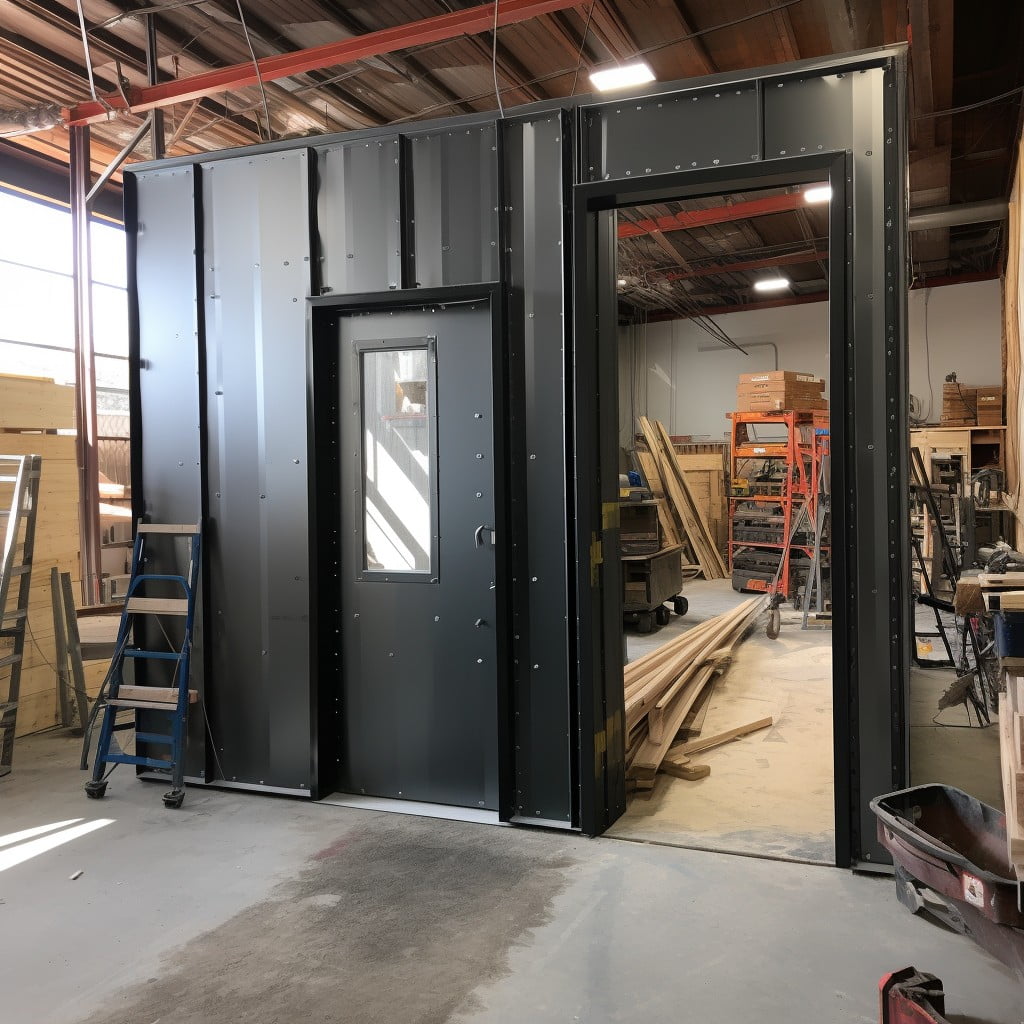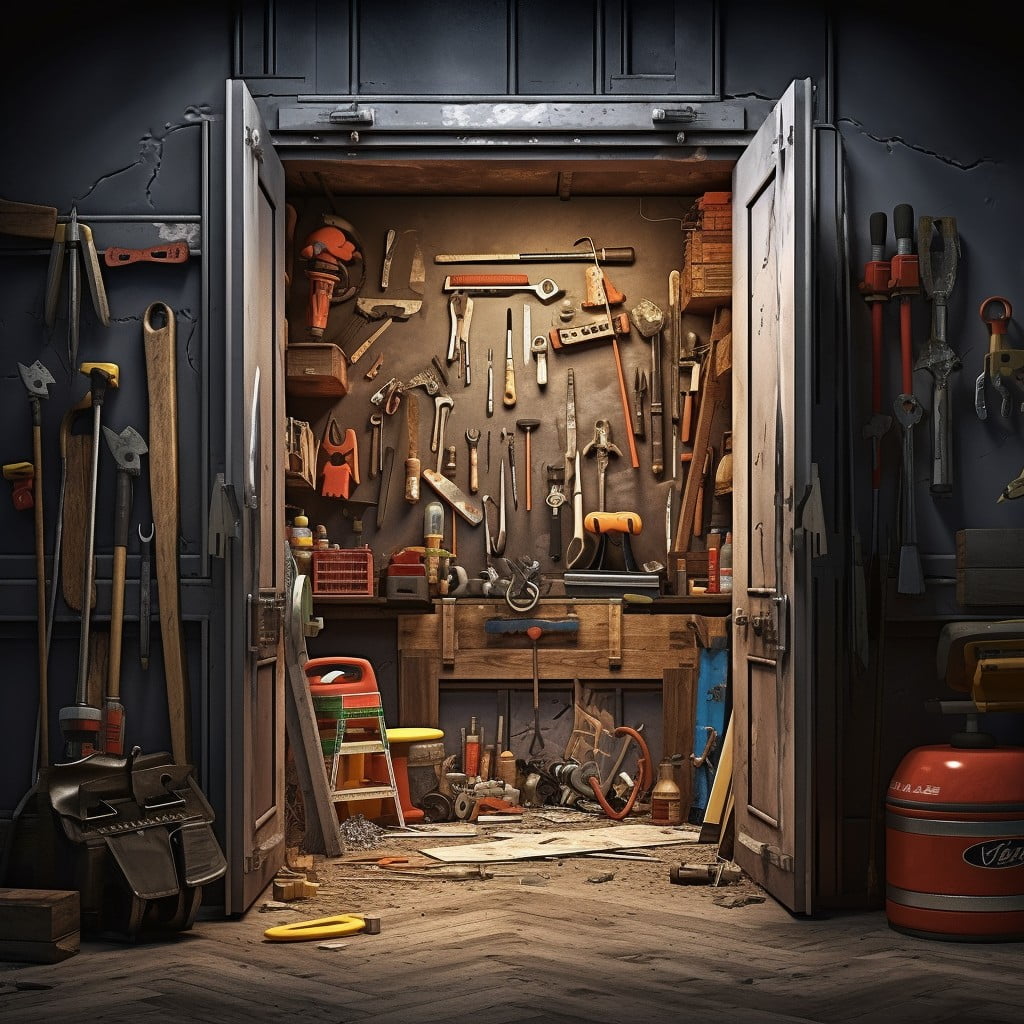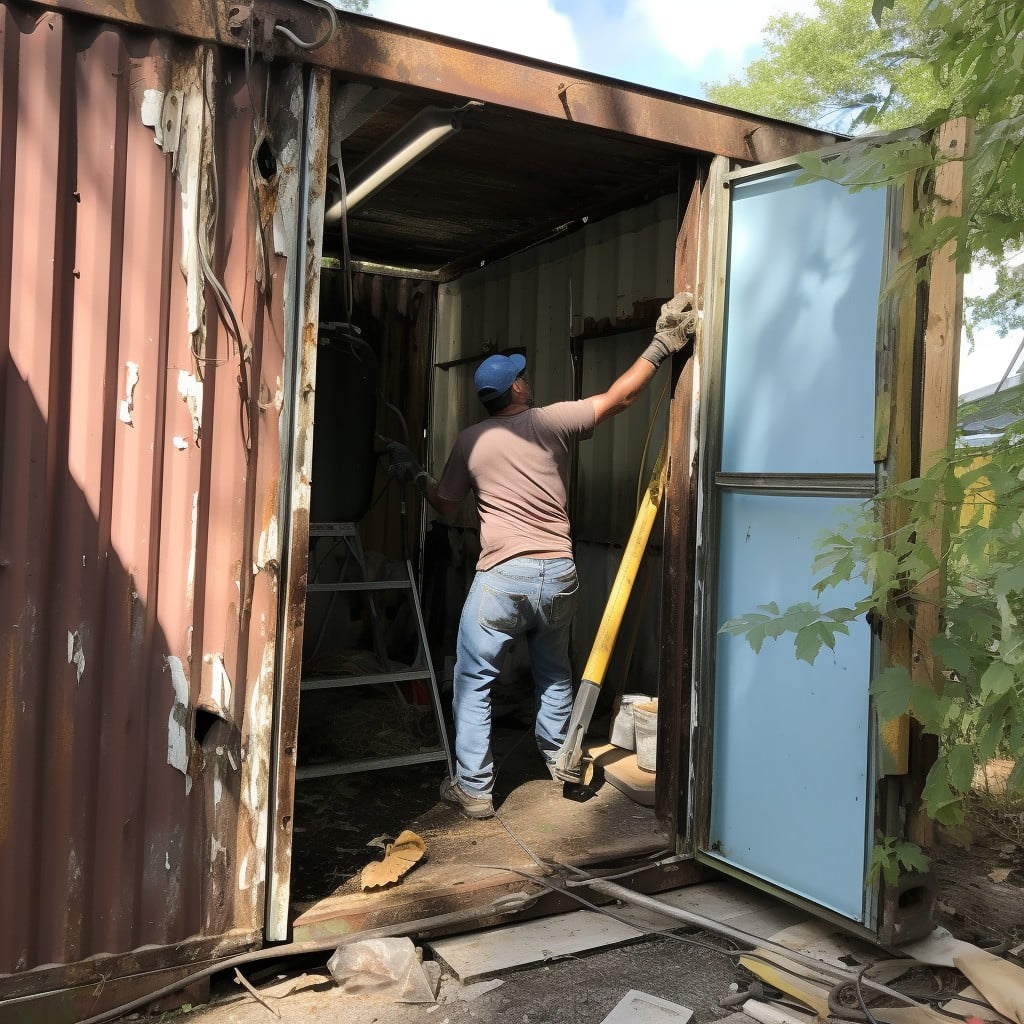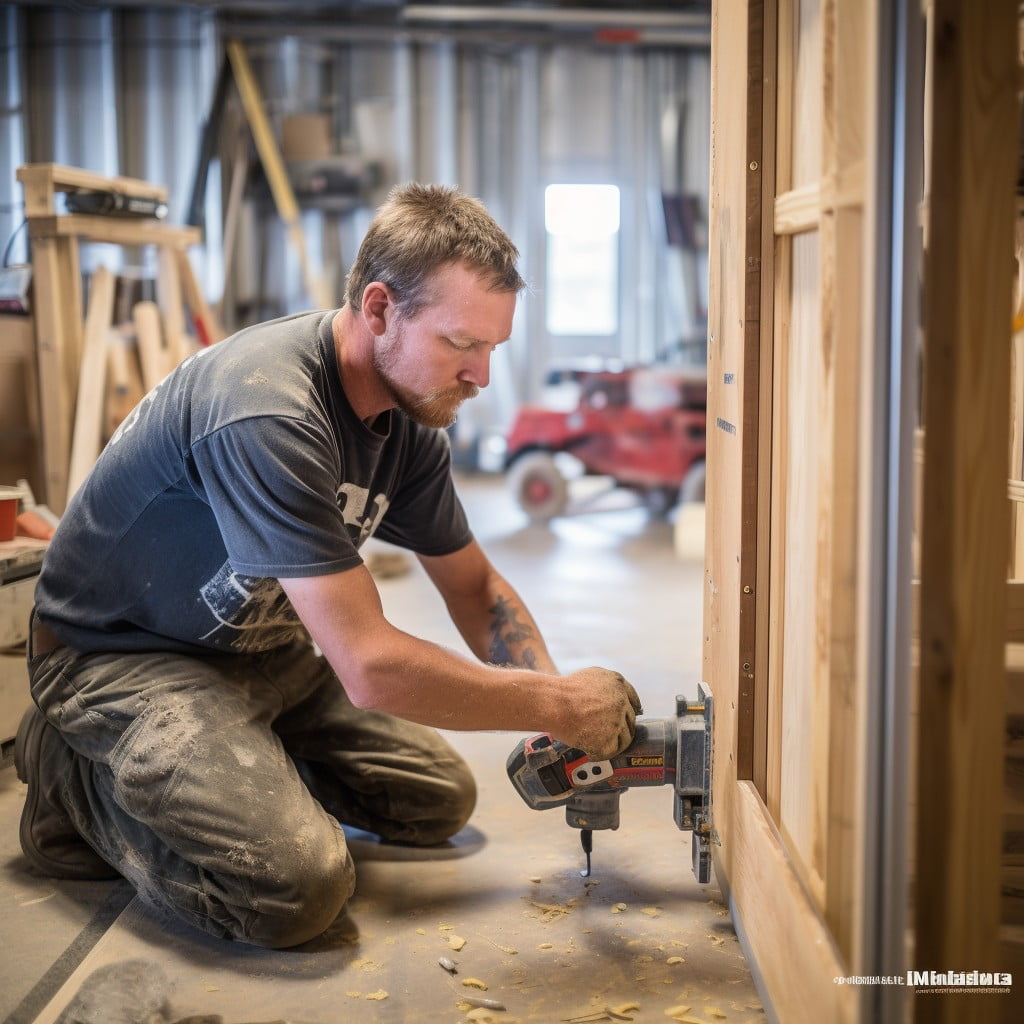In this article, we’ll delve into the step-by-step process of installing a door in an existing metal building.
Installing a door in an existing metal building can seem like a daunting task, but with the right knowledge and tools, it’s entirely doable. This article will guide you through the process step-by-step, from selecting the right door and gathering your tools, to cutting the opening and securing the door in place.
Whether you’re a seasoned builder or a DIY enthusiast, this comprehensive guide will provide you with all the details necessary to successfully install a door in a metal building.
Key takeaways:
- Choose the right door based on size, material, and fire-rating.
- Gather tools: measuring tape, level, drill, screws, metal saw.
- Remove existing door by detaching hardware and unscrewing frame.
- Frame the door by measuring, cutting the opening, installing and securing the frame.
- Install the door by measuring, cutting if necessary, setting the frame, attaching the door, and sealing for security and efficiency.
Selection of Right Door for Metal Building

When it comes to choosing the appropriate door for your metal building, there are three key factors you should consider: size, material, and fire-rating.
Firstly, the size of the door should fit the structural openings in your building, so it’s important to have accurate measurements. Narrow down your options based on the width, height, and thickness that best fits your specifications.
Secondly, the door material should be durable and match the same endurance as your metal building. Steel doors are often preferred due to their durability and the fact they can withstand harsh weather conditions.
Lastly, in certain environments, the door’s fire-rating could be an important aspect. Some doors have certifications that specify how long they can contain a fire. Therefore, depending on the building’s function, choosing a door with a high fire-rating might be a necessity to meet safety regulations.
Required Tools for Door Installation

Starting any installation process requires you to be equipped with the right tools. For this specific task, you’ll need a measuring tape, a level, and a pencil for the planning stage. This trio ensures precise measurements, straight lines, and clear marking.
Next, gather your power drill, screws, and a metal saw – essentials for implementing the actual changes. The drill and screws will secure your new door, while the metal saw is for adjusting the building’s framework if required.
Lastly, don’t forget your safety gear. Gloves, safety glasses, and sturdy shoes are non-negotiable when working with metal structures to prevent any unfortunate mishaps. With the proper tools in hand, you are now prepared to ensure a smooth, efficient door installation.
Steps to Remove Existing Door From Metal Building

Begin the removal process by detaching any existing hardware that remains on the door, such as hinges, brackets, or handles, using a screwdriver or appropriate tools. Ensure surrounding areas are protected to avoid any accidental damage during the removal process.
With assistance, hold the door’s bottom and gently lift it up and toward yourself, effectively dislodging it from the frame. Remember, safety should always be a priority when handling such bulky items.
Next, concentrate on removing the door frame. Do this by locating and unscrewing the fasteners that are usually situated along the frame edge. A word of advice: it always proves helpful to keep an organized collection of hardware for possible future use.
Lastly, clear up any debris or residue from the door space, ensuring a clean and smooth surface for the new door installation.
Guide to Frame a Door in a Metal Building

Framing a door in a metal building involves a process that requires careful precision to ensure proper installation. Here are key steps involved:
1. Measurement: Accuracy is key. Measure the size of your door and make a mark of the same dimensions on the area where the door will be installed. Include additional space to account for the door frame.
2. Cut the Opening: Using a metal cutting tool, carefully cut along the marks you’ve made. Remember, it’s easier to cut more metal away if the opening is too small than to deal with an oversized hole.
3. Install the Frame: Introduce the metal or wooden doorframe into the opening. It must fit snugly. If it’s loose, you may need to add some material to ensure a tight fit.
4. Secure the Frame: Using suitable fasteners, secure the door frame to the building. Ensure it’s level and square – this is crucial for the operation of your door.
5. Reinforce the Frame: Reinforce the door frame with additional beams or braces as necessary. This strengthens the structure to hold the weight of the door.
Following these steps will help establish a stable, secure door frame in your metal building. Up next, the door installation starts.
How to Install a Door in a Metal Building
Before beginning, ensure you have necessary tools on hand, such as a drill, screws, a level, a measuring tape, and a utility knife.
First, measure the exact dimensions of the door you will be installing, as well as the existing door frame on your metal building.
If the new door is larger than the existing opening, you may need to cut the metal panels to create a larger space.
In this case, using a metal cutting tool such as a sawzall can provide excellent results.
Always remember to wear protective gear when cutting metal to avoid injuries.
Once the space is ready, begin by setting the door frame into the opening from the outside.
Use your level to ensure the frame is plumb and square in the opening.
This is crucial for the correct operation of the door.
Afterward, secure the door frame to the metal building using screws.
Make sure these are rated for use in metal buildings to prevent corrosion over time.
Now it’s time to install the door in the frame.
Attach the door to the frame using the provided hinges.
Again, use your level to ensure that the door is sitting plumb in the frame.
Attach the doorknob hardware as per the manufacturer’s instructions.
Lastly, seal around the frame to ensure no air or water can penetrate between the building and the door by applying a bead of high-quality caulk.
This will also help increase your building’s energy efficiency.
Securing and Sealing the Door
When the door is properly placed in the frame, fasten it with the screws supplied by the manufacturer. Use a screwdriver or a drill to tighten them securely without overly straining the metal frame.
It is crucial to ensure the door is securely sealed to prevent drafts from entering the building. After fastening, apply a quality metal-to-metal caulk around the door frame. Remember to shield the door’s upper and lower corners, typically the most susceptible areas for heat loss or water intrusion.
Weatherstripping is another key aspect. Apply it to the bottom of the door and along its sides. This not only insulates your building but also provides a barrier against pests.
Finally, install door sweeps to the bottom of your exterior doors. These will create a tight seal and ensure an efficient exchange of air, keeping the interior temperature stable and reducing energy costs.
Through these measures, your installed door will be secured and sealed adequately, ensuring maximum efficiency and durability.
Final Door Installation Check
Upon completing the installation process, it is critical to perform a final check ensuring everything is as it should be. First and foremost, examine the door alignment; it should be perfectly level off the ground, and the gaps around the edges should be even.
Next, test the movement. It should open and close smoothly without any obstructions or friction. Also pay attention to the seal; any light or air penetrating the closed door signifies an issue with the seal which must be addressed immediately.
Check the strength of the door by exerting slight pressure. If there is no movement and the structure withstands the pressure, the installation has been successful. If otherwise, tightening the fixings may resolve the issue.
Finally, analyze all hardware elements such as handles, locks and screws, ensuring they are all secure and operating correctly. This guarantees a firm door structure that offers security and durability. Remember, the attention to detail is the key to a job well done.
FAQ
How do you attach things to a metal building?
To attach items to a metal building, use galvanized nuts, bolts, and washers, with the exact length and diameter depending on the items being hung, while ensuring to accurately measure and mark the spots on the wall for attachment.
Can you add onto an existing steel building?
Yes, it is possible to add onto an existing steel building to create additional space and facilitate growth and development in various sectors like businesses and distribution centers.
Can you cut windows into steel building?
Yes, you can cut windows into a steel building, however, it's crucial to avoid sections with X-bracing, and if a specific window location is important, it should be communicated to the building company prior to the start of engineering.
What is a lean to addition to a metal building?
A lean-to addition to a metal building is a specially designed and constructed extension that increases the usable space of the main metal structure, to suit the specific needs, size, and quality preferences of the user.
How can insulation be added to an existing metal building?
Insulation can be added to an existing metal building by applying it to the interior walls and roof using adhesive, or by installing it within a new layer of interior wall panels.
What are the steps to repair a damaged section of a metal building?
To repair a damaged section of a metal building, one must identify the extent of the damage, acquire suitable metal replacement materials, remove the damaged section, replace it with the new material, and secure it properly.
What type of paint is suitable for exterior metal building surfaces?
Acrylic latex paint is suitable for exterior metal building surfaces due to its durability, excellent adhesion, and resistance to weather and UV light.
Recap




